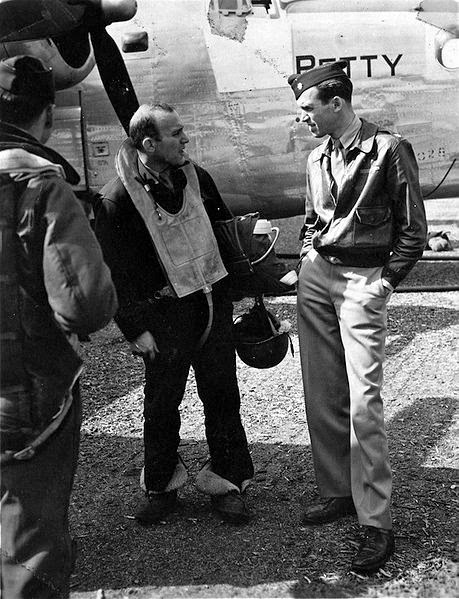JAMES STEWART AND WORLD WAR II
Jimmy Stewart was one of my favorite actors. I grew up watching his movies and I can't imagine a modern, day big name actor, of the caliber of a James Stewart, volunteering to serve their country today. War or no war. During World War II it was routine for actors and actresses to serve their country. Stewart on the other hand was the first major movie star to enlist. One thing that was special about him was that he served before America entered the war. On September 16, 1940 America enacted a peace time draft. The bill called for 900,000 men to be drafted between the ages of 20 and 36, each year. Stewart's draft number was 310 and his number came up in February. He was rejected because he was five pounds under weight and only weighed 138 pounds. At 31 Stewart was older than most recruits for the Army, but as a skilled pilot in private life, he wanted to enroll in Army-Air Corps flight training. He would turn 32 in May, which would make him too old for flight school. Stewart ate every fattening food that he could get his hands on. He was only an ounce over when he returned for a weigh in. He was inducted as a private and was the first actor to join the military.
Stewart was at the top of his career when he enlisted in the Army Air Corps. His top two movies had been Mr. Smith Goes To Washington in 1939 and Philadelphia Story in 1940. Stewart started his career in 1936 with Wife Vs. Secretary, and his last movie after induction was Pot of Gold, in 1941. In January 1942 he was commissioned a 2nd Lieutenant and sent to Mather Field in California. He was a bomber instructor where he taught pilots how to fly B-17 and B-24 bombers. America declared war on Japan on December 8, 1941. A few days later Hitler declared war on America. Stewart wanted to fly bombers in combat. Because he was a popular celebrity his superiors kept him stateside for almost two years. Stewart persisted however and wore his commanders down. He was sent to Tibenham England as a Captain in November 1943 and flew B-24 Liberators. Stewart flew 20 combat missions. His missions included raids over Berlin, Brunswick, Bremen, Frankfurt, and Schweinfurt Germany. Stewart was commander of a 1,000 bomber raid over Berlin. He was awarded the Distinguished Flying Cross with two Oak Leaf Clusters, the Air Medal with three Oak Leaf Custers, and the French Croix de Guerre with Palm. These 20 missions didn't include the missions that were called milk runs. These were bombing raids over railroad yards, and other lesser targets, that could be just as dangerous to bomber crews as raids deep into Germany.
When I pulled a summer camp at Rhein-Main A.F.B. Germany in 1983 our unit was doing Air Base Ground Defense training in the woods around the base. I was hiding in huge depressions in the ground. It suddenly dawned on me that these were shell holes caused by 500 and 1000 pound bombs dropped by American bombers during the war. It is a miracle that Stewart survived the war uninjured. The air war in Europe was brutal. Stewart was a Colonel by the end of the war and remained in the Air Force Reserve. He was promoted to Brigadier General in 1959. In 1966 he flew one combat mission in Vietnam as an observer on a B-52. Stewart retired from the Air Force in 1968 which was the year that I enlisted. After a vacation spent with his parents at the end of World War II he would go on to make one of my favorite movies of all time, "It's A Wonderful Life", in 1946.
 |
| Stewart at the time of his induction |
 |
| Stewart with his crew |
 |
| Brigadier General James Stewart |




Comments
Post a Comment